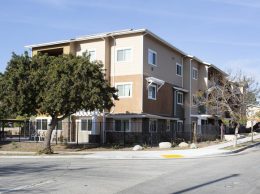The approval process for Cottage Health System’s Bella Riviera affordable housing project was described as “long and gruesome” at the recent Santa Barbara Housing Conference.
At the conference, held April 10 at the Carrillo Recreation Center, architect Brian Cearnal quipped that he got old designing the project.
Even though it took nearly a decade to complete, it’s still one of the few examples of employer-developed housing on the South Coast. And it’s a model that’s helped clear a path for others trying to fill a gap in one of the nation’s least affordable housing markets.
Recently, the largest developer of affordable housing on the Central Coast, Peoples’ Self-Help Housing, and architect Detty Peikert of Peikert + RRM Design Group teamed up to develop a new affordable housing development model. At the same time, the Housing Trust of Santa Barbara has launched a new down payment loan fund aimed specifically at South County homebuyers. The two programs could potentially be used in tandem, but heavy buy-in from employers large and small is needed to make them work.
Nestled in the hills of Santa Barbara’s Riviera neighborhood, Bella Riviera is a collection of 115 townhomes, villas and cottages. Sweeping views of the coastline are visible from the two- and three-story Spanish and craftsman homes. A majority of the complex — 81 units — is designated as affordable housing and Cottage employees from Santa Barbara Cottage Hospital, Goleta Valley Cottage Hospital, and Pacific Diagnostic Laboratories all call it home.
“We had a really tough time with turnover back in the early 2000s,” said Ron Biscaro, vice president of housing and real estate development for Cottage Health System. “It runs about 7 to 8 percent on average, but our housing issues turnover is now only about 1 percent.”
Cottage formed the Villa Riviera Real Estate Co., a for-profit subsidiary of the Santa Barbara Cottage Hospital Foundation, in 2010 to manage housing development and work with its existing mortgage assistance program. That made a big difference in how Cottage’s employees could qualify for the units, Biscaro said. Cottage also signed an affordability covenant with the city, which drove its policy process, he added.
The cost to build Bella Riviera, including the land, was about $59 million, which included a $12 million subsidy. That put net sales at about $47 million, creating a per unit subsidy for buyers of about $150,000.
Biscaro said the project included a lot of hand holding with mostly first-time buyers and concerns employees didn’t want to live together all in one place.
“We needed strong collaboration with the city, our staff and lenders,” Biscaro said. “That made a great three-legged stool to make sure people got what they wanted.”
While employers like Cottage have the resources to build large-scale projects, small- to medium-sized companies are for the most part left scratching their heads.
That’s where Peoples’ Self-Help Housing and the model that Peikert developed step in. The model aims to create limited partnerships in which the employer becomes an investor to raise the capital required for a project. In this scenario, a portion of the employers’ equity is passed on to each employee as a buyer, and Peoples’ Self-Help Housing acts as the general partner in the project and assumes most of the risk.
“When you start to talk about … selling or renting units for less than market [value], you start to lose the for-profit environment,” said John Fowler, executive director of Peoples’ Self-Help Housing. “It seemed as though the nonprofit area is exactly where this program needs to rest.”
Peikert and Fowler are collaborating on a $6 million, 14-unit project in downtown Santa Barbara, making use of the city’s Average Unit Density program, which allows developers to build up to 63 units per acre instead of the usual 35.
Peikert estimates the condos could be priced at about $490,000 for employees, and even cheaper if the employer partners leave their equity share in the project. With an estimated mortgage of around $2,500 per month, Peikert said that’s likely cheaper than rent.
With the additional ability for buyers to access the Housing Trust of Santa Barbara County’s new fund, home ownership could be in reach for more people. The new $2.5 million fund would look to make about 25 loans, up to $100,000 each, for workforce homebuyers who need help with down payments.






 Print
Print Email
Email
















